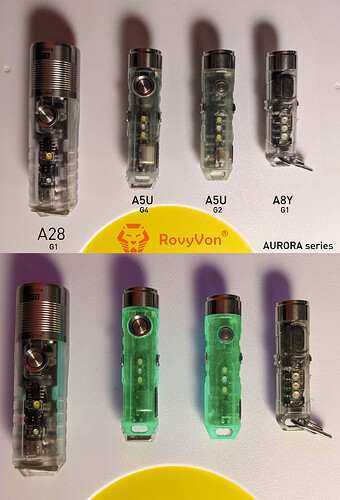There’s a lot of choice out there today for small EDC / keychain flashlights. RovyVon got started specializing in them. The Aurora series has been their best seller. And today you can get it in a variety of materials, including limited edition etched / colorized titanium. I’ve seen what happens to anodized metal objects on keychains (or rubbing next to keys), and they look pretty beat up in due time. The polycarbonate and opaque plastic bodies fair better. My preference is the clear polycarbonate, which exposes the internals and is super tough, as well as the advantage of side LED’s.
I got my first RovyVon flashlight over 5 years ago. The Aurora A8. Better review, HERE. At the time it was the 1st gen. I was seriously impressed by it, despite the relatively high price and a few minor drawbacks (anemic proprietary 120mAh battery, Micro USB, and some visible PWM).
I expect enough feedback about the PWM put sufficient pressure on RovyVon to significantly reduce the PWM by the 2nd generation and eliminate it by the 3rd generation. Also, the small Aurora series enjoyed a nice bump up in battery size, to 330 mAh. Still proprietary, though. But then, the unit is completely sealed–not facilitated access for the owner.
After the A5 3rd generation came out, I picked up a 2nd generation version with an improved control button and the 330 mAh battery. Still Micro USB charging, though. But, very nicely done overall. The price difference to get to the 3rd generation for USB-C was an appreciable jump up ($33 vs. $46).
I prefer the A5 to the A8. I don’t really see a need for amber and blue LED side light blinking. Also, the A5 comes with a polycarbonate shell infused with some GITD (glow in the dark) material. The GITD is not very strong or long lasting, but the faint glow is strong enough for a good 5 hours. My configuration preference is for the white sidelights and UV emitter. Although, sadly enough, the UV is not “true” UV in that it won’t activate UV sensitive artifacts on US currency. It’s pretty much used to power up the body’s GITD.
I picked up another A5 when it went on sale. The 4th generation. This features USB-C and a new metal button with raised metal bezel. It also has a magnetic clip (removable) and a magnetic base attachment. My 2nd gen A5 has a Nichia 219C at 4000k (450 lumens). The 4th gen A5 has an SST-20 at 6500k (650 lumens). The SST-20 is probably about 20% brighter to the human eye. But it does have a bluish tinge. So I cut out some minus-green LEE filter and adhered to the front using optical adhesive. It helped enough to be noticeable.
Finally, I spotted the A28 1st generation on a major discount compared to original price (about 50% off), because the 2nd generation is out. Cheaper than the A5 I’d bought. The 1st gen has a single metal control button and a noticeably larger body to house a 600 mAh battery. It’s about the size of a Wurkkos TS-10. And one might argue that the TS-10 is a much better value. However, the A28 is multi-function (primary and secondary side emitters) and has a fixed position clip. It was inexpensive also due to the cool white emitter (instead of warm white). Like the A5, also a bit bluish in tint, so I adhered some minus-green filter to reduce it with good success. The UV emitter is true UV, and will light up UV sensitive artifacts on bill currency.
The A28 does have an unusual feature for the RovyVon Aurora series in that the front end can be unscrewed for access to the internals. You can actually change the battery on this. However, it’s a proprietary battery… so RovyVon charges a whopping $30 for replacement. Anyway, my oldest RovyVon is a little over 5 years now and the battery is still in very good shape.
I was hoping RovyVon would eventually do a slightly larger A5 / A7 (500 mAh), but the company decided to explore a different kind of model. The Angel Eyes E-Series. E1, E3, E4, E5, E7, E8. Proprietary battery still there, but also a slot for an AAA battery. Sadly, it can’t take a 10440 LiIon cell. Nor NiMH (too weak). The AAA is intended for an extension of runtime, but it comes at a price–weaker output (low 50%, med 20%, high 13%). Frankly, a smarter move would’ve been to double the proprietary battery (IMHO).
I think for the Aurora “A” series, things are tapping out. I don’t know where else RovyVon can go at this point other than possibly adding a few more UI functions (like clearing memory and LED flash indicator for voltage remaining).
